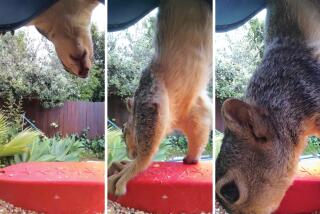Get to Root of Gopher Gobbling
Those who have the little critters claim that there is nothing harder to get rid of than a gopher, and that just about the only sure-fire method of protecting plants from their below-ground gobbling is to encase the roots in wire cages. Difficult to make, these cages are now commercially available in 1-gallon sizes ($23.50 a dozen), 5-gallon sizes ($38.50 a dozen) and 15-gallon sizes ($28.50 for six).
They are hot-dipped in zinc to guard against corrosion, and the little bit that shows above ground is green in color. The openings in the wire mesh are only 3/4-inch, so the little guys can’t get their heads inside for even a sample.
Root Guard Gopher Barriers are available from the Natural Gardening Co., 217 San Anselmo Ave., San Anselmo, Calif. 94960, (415) 456-5060.
Focal Points
Sometimes the only thing a garden design needs is a point of focus--a place to look first before the eye wanders to other delights in the garden. To make the garden appear larger, this focal point should be in the distance and it should be interesting enough to invite further inspection, thus drawing one out into the garden.
At the French formal garden of Versailles, the focal point is a several-story tall statue of Hercules. In Spanish gardens it is usually a fountain. In your garden it might be a dragonfly.
The totem-like landscape sculpture shown here is just one of several offered by a new company in Michigan named Placer Design, and they are available by mail (write for a catalogue, to Placer Design, P.O. Box 7371, Dearborn, Mich. 48121-7371). They are made of red cedar and have been influenced by native American designs and other primitive art. Several also have bird houses and attached feeders, and they stand about 6 feet tall and sell for around $170.
Placer Design also makes decorative bat houses for the garden. Bats are voracious insect eaters and they do exist in Southern California, and are sometimes seen feeding at dusk. Whether our bats will move into a bat house is an open question, though on the East Coast they do move into these specially darkened dwellings.
Rose Ratings
The American Rose Society published a handy little book that rates all the roses--from 0 to 10--and will fit in your pocket so you can take it rose shopping. ‘Mister Lincoln’ gets a 9.1, ‘Double Delight’ a 9.0, while ‘Gray Pearl’ gets a 3.2, which is probably why you’ve never heard of it. The “1989 Handbook for Selecting Roses” costs $1 and a self-addressed stamped envelope. Send to The ARS, P.O. Box 30,000, Shreveport, La. 71130-0030.
Hope in the Shade
As gardens grow older, they get shadier, as trees and shrubs cast their shadows on ever more ground. For those in this predicament, here are some suggestions from the Professional Plant Growers Assn. for annual bedding plants that will grow in shady situations--four hours of sun or less.
All of the following can be planted now: ageratum, alyssum, aster, bedding or tuberous begonia, browallia, Chinese forget-me-not, coleus, forget-me-not, impatiens, lobelia, nicotiana, pansy, salpiglossis and torenia.
Manual Mowers
Gardens used to be very peaceful places until most of the gardening machinery from mowers to blowers became motorized. Now people often retreat indoors for a little peace, where the television and kids seem so quiet in comparison with the racket outside.
It is perhaps not too surprising then to find out that manual lawn mowers are making a comeback (pictured are three models by American Lawn Mower Co., P.O. Box 369, Shelbyville, Ind. 46176). They make a pleasant whirring noise, have no exhaust, are easy to store, will not fling rocks or other objects at walls and observers and cost less than a power rotary mower. However, in Southern California they have a difficult time cutting tough St. Augustine or Kikuyu grass lawns and sometimes stumble on Bermuda as well, though these can be cut if the lawn is not too large. They do a very neat job of mowing the new tall fescue lawns and, if kept halfway sharp, will not cause the tips of the blades to turn brown after mowing because their reel action cuts cleanly.






